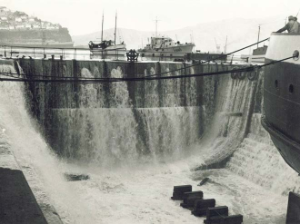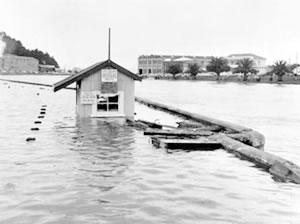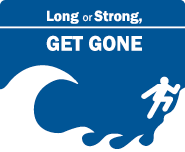
We need to talk about tsunamis: World Tsunami Awareness Day
5 November is World Tsunami Awareness Day!
Um…yay???
While this seems like an odd thing to celebrate, it gives us a chance to talk about tsunamis, because these happen and can affect the coast of New Zealand. As an island nation on the “Ring of Fire”, New Zealand has been visited by tsunamis frequently in our past.
So, first, let’s take a quick tour our tsunami history.
Tsunamis in New Zealand Oral histories from Maori have provided a wealth of knowledge regarding tsunamis in New Zealand. We have another way we know about tsunamis from 1840s to now: written records. People wrote letters and newspaper articles about tsunamis. Also, we know about tsunamis through geological investigations, like trenching. We basically dig some holes and find out what the ground and rocks and tiny fossils can tell us through the use of chemistry, observation and mapping out sediments and soils.
The last tsunami to visit our shores was pretty recent: the M7.1 East Cape earthquake in September this year. While the tsunami was small (30 cm), it still was quite disruptive to sea conditions and beaches. Here is a great video that shows even small tsunami can be pretty dramatic from Christchurch in February 2010 (which came from Chile).
What causes tsunamis? Tsunamis are typically caused by a shallow earthquake in the ocean, which disrupts the seafloor and that moves a bunch of water quickly and with a lot of force. This brings us to…
Megathrusts (!!) Despite the delightfully colourful name (is it me or would that make an excellent super hero name? Marvel, get on that!), megathrust earthquakes are actually quite serious and damaging. Megathrust earthquakes occur where two plates meet and one plate pushes the other one up. Similar to you pushing your sibling away when they are sitting on top of you, you’ve just had enough and you explode with rage to get them away from you. Here's a great video on a simulation of what that might look like.
Megathrust earthquakes have caused large tsunamis in New Zealand’s past. Researchers have found evidence of a 3 metre plus tsunami striking the east coast of the Lower North Island and upper South Island generated in the 1100s A.D. from a megathrust earthquake along the Hikurangi Margin. There is a lot of evidence for other megathrust earthquakes and related tsunami off the East Coast of the North Island and the Upper South Island.
| __Tsunami date | Cause | Quake magnitude | Max wave height | Affected area__ |
|---|---|---|---|---|
| 22 August 2003 | Fiordland Earthquake | 7.2 | 5.0m | Charles Sound |
| 23 May 1960 | Chile Earthquake | 9.5 | 4.5m | Entire East Coast of New Zealand, Fiordland, Nelson, Chatham Island |
| 25 March and 17 May 1947 | Offshore Gisborne Earthquake | 6.9-7.1 | 10m | Tolaga Bay to Castle Point |
| 19 July 1924 | Unknown – local earthquake | unknown | 3-6m | Chatham Island |
| 28-29 August 1883 | Krakatau Volcano, Indonesia | NA | 1m | East Coast of New Zealand, Taranaki, Nelson, Invercargill |
| 11 May 1877 | Chile Earthquake | 8.3 | 2m | Entire East Coast of New Zealand, Taranaki, Westport, Hokitika, Invercargill, Chatham Islands |
| 15 August 1868 | Chile Earthquake | 9.0 | 5-7m | East Coast of New Zealand, Taranaki, Whanganui, Nelson, Westport, Greymouth, Hokitika, Invercargill, Chatham Islands |
| 23 January 1855 | Wairarapa Earthquake | 8.2 | 11m | Wairoa, Palliser Bay, Wellington, Clarence, Kaikoura, Wairau Valley, Nelson, Takaka |
Significant tsunamis are triggered by a large magnitude (M7.5 plus) earthquake. Or an underwater landslide. Or even a volcano erupting. Tsunamis can also be caused by glaciers breaking up in a lake. Or the Earth can have a really bad day and get smacked by an asteroid. That can also cause a tsunami but, that would probably be the least of our problems at that point. Anyway, before we go fully down that "look at all the ways tsunamis are bad", let's get more productive.
How we know a tsunami is coming
The fastest way to know a tsunami is coming is if a strong or long earthquake happens near the coast.
If it is a distant source tsunami, we have more time. These types of tsunami mostly come from the South American coast. In this case, our tsunami experts panel has time to meet, look at the models and discuss what might happen with our good friends at the Ministry of Civil Defence and Emergency Management (MCDEM). MCDEM then announce any public safety warnings, watches or threats to New Zealand.
In that instance, we highly recommend people make the decision to evacuate themselves. Officials from local, regional and national Civil Defence may simply not have the time to tell people to evacuate, so the best decision is to evacuate if you feel a long or strong earthquake.
If you are interested in GeoNets tsunami gauge network click here.
What we can do about tsunamis This brings us back to why we need to talk about tsunamis. I’m not going to sugar coat this for anyone: tsunamis can be very damaging. While we do make jokes about megathrusts, we are in no way flippant about how damaging tsunamis can be. As scary as tsunamis can be, there are some things we can do right now to get ready when these strike our shores next.
We can’t stop tsunamis from happening BUT we can prepare for these. Want to know how? Here are some great places to go to get more information about New Zealand and preparing for tsunamis: - Ministry of Civil Defence and Emergency Management - EQC - East Coast Lab - Also, visit your local or regional council for tsunami evacuation maps.


